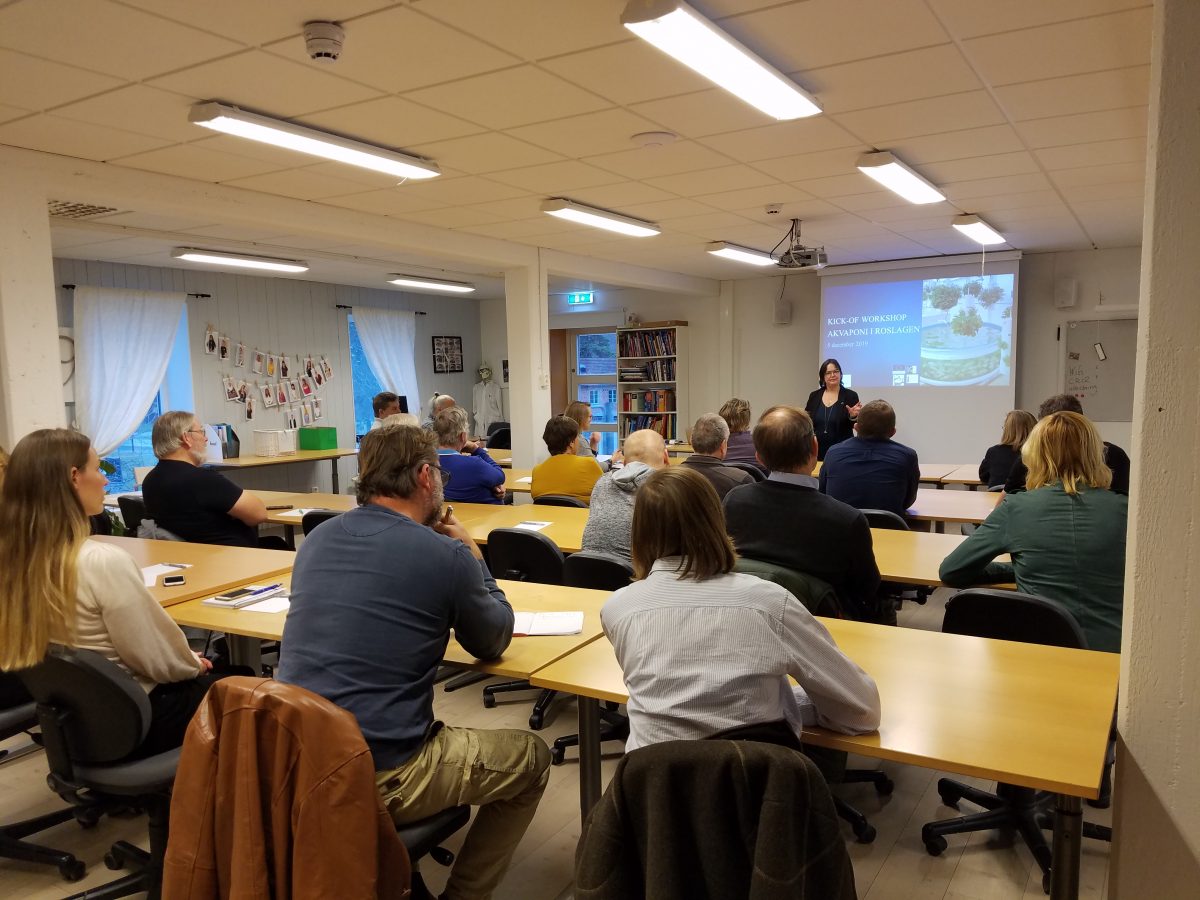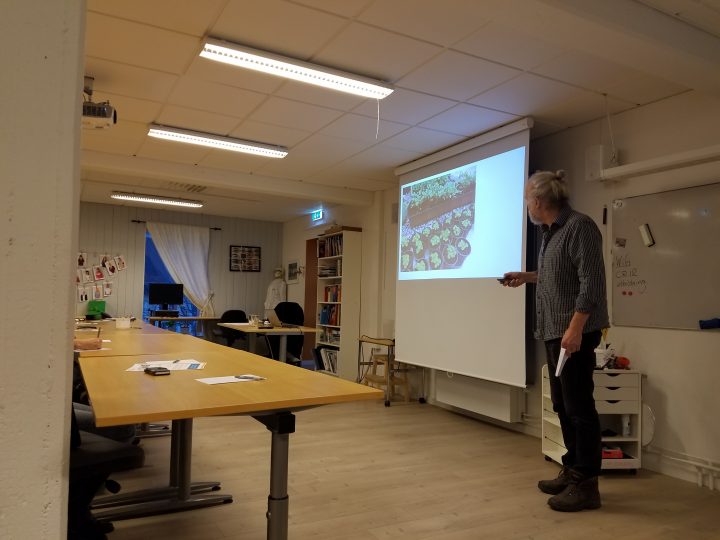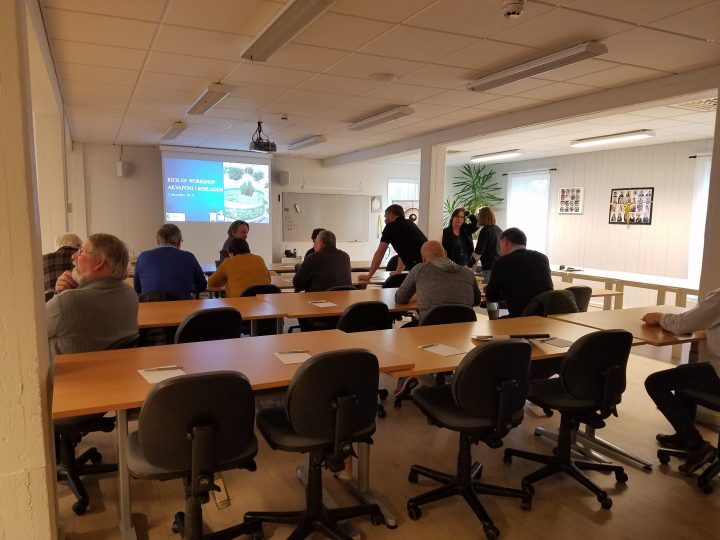06-12-19Samtal om hållbar matproduktion och Akvaponi

Den 5 december hölls en workshop om hållbar matproduktion och Akvaponiska system på Utvecklingscentrum för vatten.
Dagen fick en bra uppslutning med deltagare från såväl Stockholm och Norrtälje samt Åland. Bland de 25 deltagare som närvarande fanns representanter från bland annat Pensionat Stalldalen, Kröns Trädgård, Gröna Lund, Väddö hälsoträdgård och Norrtälje kommun för att nämna några.
Stort tack till alla som deltog – vi är glada att det finns ett stort intresse för Akvaponi och hållbar matproduktion!
Arbete med projektet Akvaponi i Roslagen kommer fortsätta under 2020 och UCV ser fram emot kommande arbete och diskussioner inom området. Anmäl er gärna till vårt nyhetsbrev för information om våra kommande evenemang eller titta in vår hemsida och facebookgrupp.

Fler Nyheter
24/10/20 - 13:45
Installation av filter på Ljusterö
Ett av filtren i projektet "Utvärdering av reningsteknik för att säkerställa dricksvattenkvalitet av enskilt dricksvatten" installerades på Ljusterö
Under hösten har det varit full aktivitet med att installera filter för att testa vanligt förekommande reningstekniker. Fokus ligger på parametrarna bly, uran och arsenik i enskilda dricksvattenbrunnar med kända kvalitétsproblem.
Det senaste filtret installerades på Ljusterö och nu skall reningstekniken utvärderas.
Läs mer om projektet på projektets sida.
10/09/19 - 14:21
Inspiration Ålands Hav – grannar till havs
Utvecklingscentrum för Vatten deltar i en konferens om hållbar utveckling på lokal nivå gällande möjligheter, hot och utmaningar som delas av Roslagen, Åland och Åbolands skärgård.
Hur skapar vi tillsammans en hållbar utveckling på lokal nivå?
En dag om de möjligheter, hot och utmaningar som delas av Roslagen, Åland och Åbolands skärgård.
Klicka här för inbjudan med mer info och program
Datum: Torsdag den 10 oktober
Tid: 09.45-17.00
Plats: Folkets Hus i Norrtälje, Galles Gränd 5
11/03/24 - 11:31
Vattencentrum stängt 13-14 mars
Vattencentrum håller stängt onsdag-torsdag 13-14 mars på grund av konferens.
Vi har öppet som vanligt från kl 10.00 fredag 15/3
25/09/20 - 13:19
"Akvaponi I Roslagen” participates to #EUinmyregion campaign
How the aquaponics helps complying with the sustainable development goals
With the project “Aquaponics in Roslagen” we aim to raise awareness around the social and
environmental challenges facing the food sector and the importance of adopting circularity
processes, to spread information about aquaponics and inspire different actors to adopt this
type of farming technique.
The food sector is called to face many challenges such as an increasing world population,
70% of which will live in cities and an overuse of our resources e.g. 70% of the world’s fish
stock is either fished at its limit or over fished.
Agriculture more than other sector depends on weather and climate. It will be particularly
impacted by climate change, some of its consequences being desertification, land erosion,
droughts.
Moreover, Sweden strongly depends on food imports, especially for fish, fruit and vegetables,
this contributing to CO2 emissions but also undermining the security of the Swedish food
system.
There is the need to transition towards a more sustainable and resilient food system, possibly
bringing food production closer to the consumer.
Aquaponics is a circular farming method that allows saving of water and nutrients. It
combines the culture of fish or other aquatic species with the farming of vegetables. Nutrients
rich water from fish culture flows to the growing beds and then sent back to the fish in a
circular loop. Bacteria are the stars of this system: They are responsible of the conversion of
ammonia into nitrites and then nitrates, a non-toxic form of nitrogen.
The ecosystem fish-bacteria-plant is a very sensitive one and is based on an equilibrium of
nutrients and water parameters.
How aquaponics contributes to the agenda 2030:
- • Aquaponics uses only 10% of the water used in traditional agriculture (FAO, 2014)_ SDG 6
- • Soil-less agriculture halts the depletion of soil nutrients_SDG 13, 15
- • No harmful fertilizers run off into water bodies. In traditional agriculture, farmers have to use fertilizers in order to maximize the production. The excess of fertilizers goes then to our water bodies, causing eutrophication and in extreme cases to the biological death of the water source_ SDG 14
- • In an aquaponic system the wastewater from fish is not only controlled but reused, being this an alternative and more environmental-friendly method of fish farming_ SDG 6 & 14
- • Thanks to the symbiosis between fish and vegetables, in aquaponics it is impossible to use antibiotics for fish, contrary to sea fish farming. This means that good conditions for the fish health need to be respected, being this a guarantee both for the end consumer and under the aspect of animal protection_SDG 3, 14
- • It is possible to produce in the city where the arable land available is quite limited thanks to the possibility offered by the vertical farming_ SDG 2, 11
- • Food transportation contributes largely to CO2 emissions in the atmosphere. By taking food production closer to the consumers aquaponics can have a positive effect also on this aspect_SDG 11,12,13
- • Aquaponics can be a way to ensure food security: By being able to cultivate all year around in controlled conditions that do not depend on external and climate factors we can prevent the interrumption of the food chain, particularly important under pandemics times_SDG 2
- • Soil-less farming methods are suitable for any gender, age, and even allow people with disability to work in this field since they don’t require all the movements needed in traditional agriculture_SDG 10





